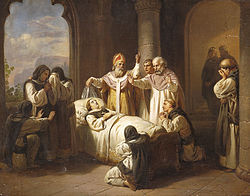- Saint Margaret of Hungary
-
Not to be confused with Margaret of Hungary.
Saint Margaret of Hungary 
Molnár József's "The Death of Saint Margaret"Born January 27, 1242
Klis Fortress, Klis
(today's Croatia)Died January 18, 1271 (aged 28)
Margaret Island, Budapest
(today's Hungary)Honored in Roman Catholic Church Beatified 1789 Canonized November 19, 1943 by Pope Pius XII Feast January 18 Attributes depicted in a nun's habit, with a white lily and holding a book in her hand Saint Margaret (January 27, 1242 – January 18, 1271) was a nun and the daughter of King Béla IV and Maria Laskarina. She was the niece of Saint Elizabeth of Hungary and the younger sister of Saint Kinga and Blessed Yolanda.
Contents
Early life
She was born in Klis Fortress as the eighth and last daughter (9th of 10 children) of the royal couple, when they lived in exile in Croatia during the Mongol invasion of Hungary (1241–42).[1] Her parents vowed that if Hungary was liberated from the Mongols, they would dedicate the child to religion. Four-year-old Margaret entered the Dominican convent of Veszprém in 1245. Six years later she was transferred to the Convent of the Blessed Virgin founded by her parents on the Nyulak szigete ("Rabbits' Island") near Buda (today Margaret Island, named after her, and a part of Budapest. The ruins of the convent can still be seen.) She spent all her life here, dedicating herself to religion and opposing all attempts of her father to arrange a political marriage for her with King Ottokar II of Bohemia. She appears to have taken solemn vows when she was eighteen years old.
Much of the details of her life are known from the Legend of Saint Margaret, written probably in the 14th century and translated from Latin to Hungarian in the 15th. The only remaining copy of the legend is in the Margaret Codex copied by the Dominican nun Lea Ráskay around 1510. According to the legend, Margaret chastised herself from early childhood, wore an iron girdle, hair garments and shoes spiked with nails. She also performed the dirtiest works in the convent.
Veneration
She was venerated as a saint already in her lifetime, e.g., a stone church was dedicated to her in Bocfolde, Zala county, and steps were taken for her canonization shortly after her death, at the request of her brother King Stephen V. The necessary investigations were taken up between 1271 and 1276, but the canonization process was not completed, even though seventy-four miracles were ascribed to her, most of them referring to her curing illnesses and awakening someone from death. Among those giving testimony were twenty-seven in whose favour the miracles had been wrought. Unsuccessful attempts to canonize her were also made in 1640 and 1770. She was finally canonized by Pope Pius XII on 19 November 1943, the feast day of her aunt, Saint Elizabeth of Hungary.
Her feast day, which was raised by Pope Pius VII to a festum duplex, is the day of her death, January 18.
When the Dominican monastery was suppressed in 1782, her remains were given to the Poor Clares. They were kept in Pozsony (today Bratislava) and Buda. The relics were partly destroyed in 1789 (seven years after the suppression of all religious orders by Joseph II, Holy Roman Emperor, but some portions were preserved and are now kept in Esztergom, Győr, and Pannonhalma.
In art Margaret is usually depicted in a nun's habit, with a white lily and holding a book in her hand.[2]
Ancestry
Ancestors of Saint Margaret of Hungary 16. Géza II of Hungary 8. Béla III of Hungary 17. Euphrosyne of Kiev 4. Andrew II of Hungary 18. Raynald of Châtillon 9. Agnes of Antioch 19. Constance of Antioch 2. Béla IV of Hungary 20. Berthold III of Andechs 10. Berthold IV, Duke of Merania 21. Hedwig of Wittelsbach 5. Gertrude of Merania 22. Dedo V, Count of Wettin 11.Agnes of Wettin and Rochlitz 23. Matilda of Heinsberg 1. Saint Margaret of Hungary 24. ? 12. Manuel Laskaris 25. ? 6. Theodore I Laskaris 26. ? 13. Ioanna Karatzaina 27. ? 3. Maria Laskarina 28. Andronicos Dukas Angelos 14. Byzantine Emperor Alexios III Angelos 29. Euphrosyne Castamonitissa 7. Anna Komnena Angelina 30. Andronikos Doukas Kamateros 15. Euphrosyne Doukaina Kamatera 31. ? References
- ^ "Klis –vrata Dalmacije [Klis – A gateway to Dalmatia]" (in Croatian) (PDF). Građevinar (Zagreb: Croatian Society of Civil Engineers) 53 (9): 605–611. September 2001. ISSN 0350-2465. http://www.casopis-gradjevinar.hr/dokumenti/200109/6.pdf. Retrieved 2009-12-17.
- ^ Attwater, Donald and Catherine Rachel John. The Penguin Dictionary of Saints. 3rd edition. New York: Penguin Books, 1993. ISBN 0-140-51312-4.
External links
Categories:- 1242 births
- 1271 deaths
- Dominican nuns
- House of Árpád
- Hungarian Roman Catholic saints
- Hungarian princesses
- 13th-century Christian female saints
- Medieval Hungarian saints
Wikimedia Foundation. 2010.
